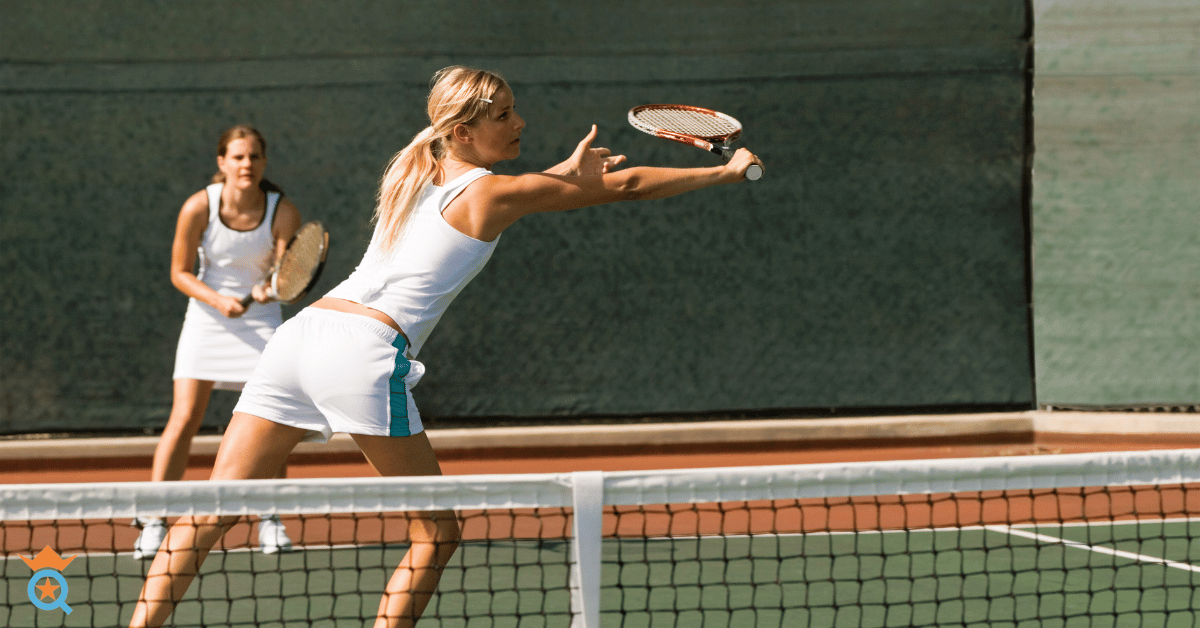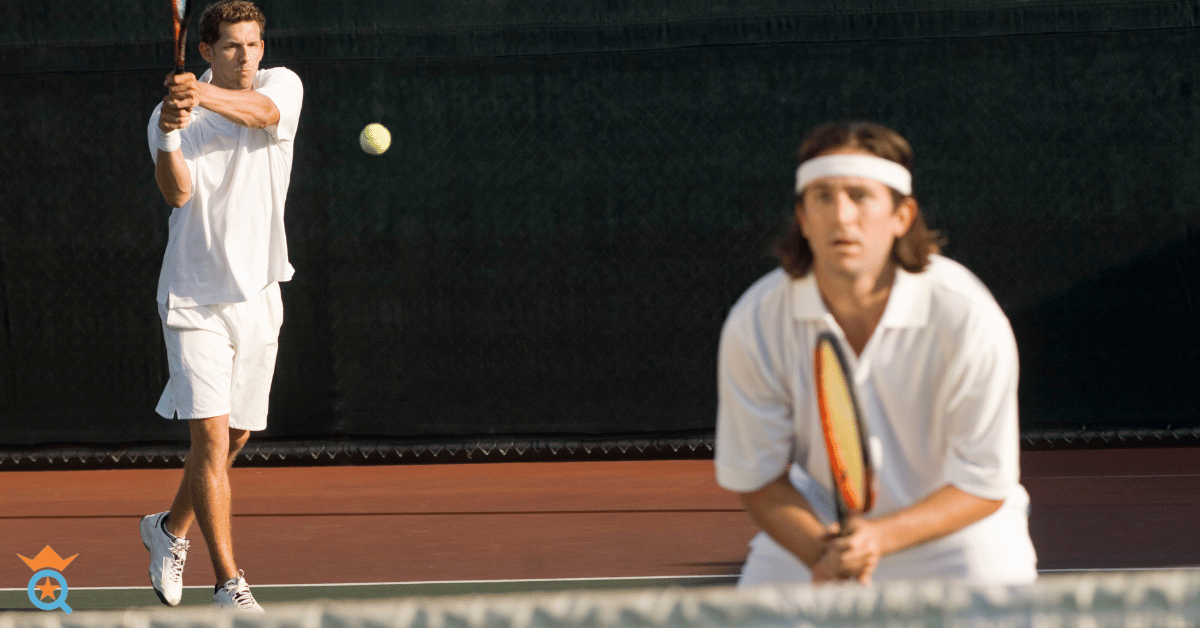Playing doubles tennis is a lot different from singles. You have a bigger court to cover, two opponents to outsmart, and another player to communicate with. That's why strategy is so important in doubles tennis, and adapting to your opponents can help you win matches.
Doubles play is unique, with a different court size, and two net players to contend with. Netplay is critical in doubles, and it's essential to understand how to use it to your advantage.
By observing and analyzing your opponents' playing styles, you can adjust your game plan, vary your shots, dominate the right parts of the court, take control of the server, work as a team to cover angles, and make your opponents uncomfortable.

Observing and Analyzing Your Opponents
In doubles tennis, observing and analyzing your opponents is essential. It's important to understand your opponent's playing styles, strengths, and weaknesses, as it can give you a competitive edge. Here are some specific examples of what to look for:
- Observe your opponent's feet. Do they move more to one side of the court? This can help you hit the ball to the opposite side.
- Pay attention to your opponent's weaker backhand volley. If you notice that they struggle with this shot, you can try to hit more balls to that side of the court.
Once you've identified your opponent's weaknesses, it's time to adjust your own game plan. For example, if your opponent is weak on their backhand volley, try to hit more shots to that side of the court. By doing so, you can force them to make errors and gain an advantage. Similarly, if your opponent tends to move more to one side of the court, you can hit the ball to the other side to keep them off balance.
Observing and analyzing your opponents is a critical aspect of doubles tennis. By identifying their weaknesses and adjusting your game plan, you can increase your chances of winning.
So, take some time to watch your opponents closely during the match and adjust your strategy accordingly. With practice, you'll become more adept at targeting your opponent's weaknesses and dominating the court.

Adapting Your Game Plan
Adapting your game plan to your opponents is a key strategy in doubles tennis. Here are some different strategies that can be used to adapt to opponents:
- I formation: This formation is useful when you want to surprise your opponents with a different look on the serve. In this formation, one net player stays back while the other player moves to the side of the court to cover the alley. The server can then choose which side to serve to, making it difficult for the returner to predict the direction of the serve.
- Advanced doubles formations: There are several advanced doubles formations, such as the Australian formation and the 3-1 formation, that can be effective in certain situations. For example, the Australian formation can be used to disrupt your opponent's rhythm on the return by having doubles players start at the baseline and move forward at the same time. The 3-1 formation can be used when one net player is particularly strong and can cover most of the court, while the other player stays back to defend the lob.
Communication with your doubles partner is also critical in adapting to opponents. During the match, make sure to communicate effectively and share information about your opponent's strengths and weaknesses.
For example, if you notice that your opponent is struggling with their backhand, let your partner know so that they can hit more shots to that side of the court. Additionally, make sure to communicate your own strengths and weaknesses, so that your partner can adjust their game plan accordingly.
Adapting your game plan to your opponents is an essential strategy in doubles tennis. By using formations such as the I formation and advanced doubles formations, and communicating effectively with your partner, you can gain a competitive edge and increase your chances of winning. So, be flexible, stay focused, and adjust your game plan as needed to dominate the doubles court.
"Adapt your doubles tennis strategy to your opponents to gain the advantage and win matches."

Varying Your Shots
Shot variation is critical in doubles tennis, as it can keep your opponents off-balance and create free points. Here are some specific examples of how to vary your shots:
- Hit to the opposing net player's feet: This is an effective strategy because it makes it difficult for the net player to volley the ball effectively. By hitting the ball low to their feet, you force them to hit up, making it easier for you to put the ball away.
- Hit to the middle of the court: When both net players are at the net, hitting to the middle of the court can create confusion and force your opponents to communicate effectively. If they're not communicating well, they may both go for the same ball, leaving an open space for you to hit into.
- Use drop shots: Drop shots can be particularly effective when your opponents are positioned far back in the court. By dropping the ball just over the net, you force them to run forward and make a difficult shot.
By varying your shots, you can create free points and put your opponents on the defensive. For example, if you hit a low shot to the opposing net player's feet, they may struggle to return it, giving you an opportunity to put the ball away. Similarly, if you hit a drop shot that catches your opponents off guard, you can follow it up with a strong shot to win the point.
Shot variation is an essential strategy in doubles tennis. By hitting to the opposing net player's feet, hitting to the middle of the court, and using drop shots, you can keep your opponents off-balance and create free points. So, be creative, mix up your shots, and dominate the court with your tactical play.

Dominating the Right Parts of the Court
Here are some tips for dominating the right parts of the court in doubles tennis:
- "Be active at the net" by constantly moving towards the net strap to limit your opponents' options and force them to hit difficult shots.
- "Look to cut the ball out from the middle of the court" instead of just covering the service line, to close off the safest parts of the court to your opponents and make it more challenging for them to hit winning shots.
- "Play smarter doubles" by looking for ways to limit your opponents' options, such as focusing on the corridor that runs a few feet on each side of the net strap and a few feet above it.
By implementing these strategies, you can force your opponents to play more defensively and increase the likelihood of them making mistakes. This creates opportunities for you to hit winning shots and ultimately win more matches.
In summary, dominating the right parts of the court is crucial in doubles tennis. Being active at the net, cutting the ball out from the middle of the court, and playing smarter doubles are just some of the ways you can outmaneuver your opponents and increase your chances of winning. So, get out there and dominate the court with your strategic play!

Making Your Opponents Uncomfortable
To succeed in doubles tennis, it's crucial to make your opponents uncomfortable and take them out of their comfort zone. Here are some tips on how to do that:
"Make your opponents uncomfortable and take control with the serve to keep them on their toes."
Observation:
- Observe your opponents playing styles, strengths, and weaknesses to identify areas to exploit
- Look for weaknesses such as the opposing net player's weaker backhand volley or their movement toward their feet
Shot Variation:
- Use shot variation to keep your opponents off-balance
- Aim for the middle of the court or hit the opposing net player's feet to create openings
Lob:
- The lob is an effective way to make your opponents uncomfortable and force them out of their dominant position at the net
- Aim for the deep court or use a topspin lob to keep your opponents on their toes
Change the Dynamic:
- Change the dynamic of the point by varying the pace and spin of the ball
- Mix up your shots to make it difficult for your opponents to predict your next move
Incorporating these strategies can make a significant impact on the outcome of your doubles match. Remember, always be adaptable and adjust your game plan to take advantage of your opponent's weaknesses.

Practicing Your Strategies
To successfully adapt to opponents in doubles tennis, it's essential to practice and improve your skills. Here are some tips on how to practice your strategies:
Communication:
- Practice communicating with your doubles partner during drills and exercises
- Use hand signals or verbal cues to improve communication on the court
Shot Variation:
- Practice hitting different areas of the court during drills and exercises
- Focus on hitting to the middle of the court or to the opposing net player's feet
Positioning:
- Practice positioning on the court during drills and exercises
- Focus on moving as a team and covering the angles effectively
Formations:
- Practice different doubles formations, such as the I formation or Australian formation, to increase confidence in adapting to opponents
- Focus on executing each formation effectively during drills and exercises
Benefits:
- Practicing your strategies can help increase your confidence and adaptability during doubles matches
- It can also help improve shot accuracy, communication, and positioning on the court
- By practicing different doubles formations and strategies, you'll be better equipped to handle different opponents and adjust your game plan accordingly
Remember, practice makes perfect, and the more you practice your strategies, the better you'll become at adapting to the opposing team during doubles matches.
Popularity of Tennis
- Adapting your doubles tennis strategy to your opponents is crucial to winning matches.
- Observing your opponents' playing styles, strengths, and weaknesses is essential in adjusting your game plan and targeting their weaknesses.
- Shot variation, communication, and teamwork are all critical in adapting to opponents and outmaneuvering them.
- Dominating the right parts of the court, varying your shots, making your opponents uncomfortable, and taking control of the serve are all key strategies in adapting your doubles tennis strategy.
- Practicing different doubles formations and strategies will improve your performance and help you handle different opponents.
- Many doubles teams have partnered with varying experience and skill. That's actually a strength and one that many teams fail to use. Acknowledge that you're not the best player, and turn to your experienced partner for guidance.
- Remember to play smarter doubles and use these tips and strategies to improve your doubles game and win more matches.
In doubles tennis, adapting your strategies to your opponents is crucial to winning matches. By observing your opponents' playing styles, strengths, and weaknesses, you can adjust your game plan to target their weaknesses and dominate the court. Shot variation, communication, and teamwork are also essential in adapting to opponents and outmaneuvering them. By practicing different doubles formations and strategies, you'll be better equipped to handle different opponents and win more matches.
So, it's time to play smarter doubles and use the tips and strategies provided in this article to improve your doubles game. Keep in mind that dominating the right parts of the court, varying your shots, making your opponents uncomfortable, and taking control of the serve are all essential to adapting your doubles tennis strategy and winning matches.
Remember to communicate effectively with your partner, focus on shot variation, and work together as a team to outmaneuver your opponents. Incorporate these strategies into your doubles game, and you'll see a significant improvement in your performance on the court.








